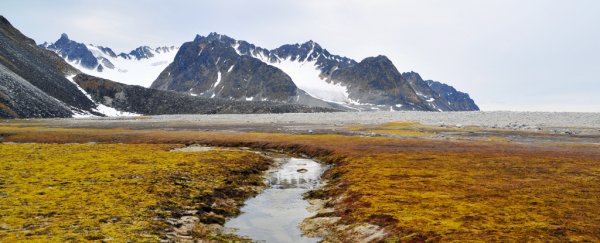Scientists on Tuesday published new evidence that old or even ancient carbon, pulled out of the atmosphere and stored in the bodies of plants hundreds or thousands of years ago, is being set loose again from soils in the Arctic region.
It's a potentially worrying indicator that these "permafrost" soils may already be worsening the problem of climate change.
However, scientists are still debating just how much old carbon Arctic soils should release normally even without climate change, leaving the ultimate significance of the findings unclear.
The new study, which was published in the journal Environmental Research Letters, employed radiocarbon dating to examine the content of river and lake waters in Canada's Northwest Territories in 2014.
It found an increasing prevalence of older dissolved carbon and carbon dioxide in the waters as the summer advanced. The research also discovered one case of carbon in methane gas that was more than 2,000 years old.
The new work isn't definitive on the question of increasing permafrost carbon emissions - but it's something to worry about, said Joshua Dean, the study's lead author and a researcher at the Vrije University in Amsterdam.
"I would say if you're looking at anything pushing several hundred years old to a thousand years old, then you have to start wondering whether that should be coming out of this kind of system," said Dean, who published the work with 11 colleagues from universities and institutions in Britain.
Over thousands of years, the Arctic has stored up massive amounts of carbon as plants have died but have not fully decayed because of the region's cold temperatures.
Instead, their roots and other plant parts have been preserved in the frozen soil. Layer upon layer of Arctic soil has built up, representing a kind of time capsule with the oldest layers, and the oldest carbon, generally found at the greatest depths.
As a warming climate thaws this permafrost, more and more of the older carbon will be broken down by microbes and released as carbon dioxide or methane, with the potential to greatly warm the planet. But it's not clear how much carbon is vulnerable or how fast such a release could happen.
That's where the new research comes in. Scientists know the precise rate at which one variant of carbon found in the atmosphere, carbon-14, decays into another variant.
Thus, by determining the ratios of these types of carbon in samples taken from the Arctic, they can determine when the carbon was first drawn out of the atmosphere and into a plant - its "age."
The new research is one in a string of studies that have used such a method to detect old carbon emerging from Arctic lakes or rivers, or Arctic soils, going at least back to 2009.
In a paper that year, Ted Schuur of Northern Arizona University and his colleagues found older carbon emerging from thawed permafrost regions in the Eight Mile Lake watershed of the Alaska Range.
Since then, a 2016 study in Nature Geoscience examined Arctic lakes in multiple regions and found that "that methane age from lakes is nearly identical to the age of permafrost soil carbon thawing around them."
Meanwhile, a 2018 study in Nature Climate Change found that carbon dioxide and methane emissions from lakes in Alaska mostly came from carbon that had been fixed by plants within the last 3,000 to 4,000 years, but also that a small percentage was even older than that.
And then there's the latest study - which was aimed at trying to establish a basic measurement of how much old carbon is flowing into the waters of the Northwest Territories region.
Determining whether those amounts are unusual, or whether levels are changing, remains for subsequent work, Dean said.
So what does it all add up to? That's the big question.
Schuur said in an email that these studies, "taken together," suggest that "increased old C release is a fingerprint of changing Arctic carbon cycle."
"Of course, magnitude matters, but I think the concept of old carbon entering the modern carbon cycle is an important one indicating change from the status quo," Schuur added.
However, other researchers have had differing interpretations.
"Yes, we can detect old carbon in these systems, but you need to know whether that is what we would expect to be happening anyway, just based on natural carbon cycling," said Dean, the lead author of the newest study.
"It is currently unclear what constitutes a 'steady state scenario' for various Arctic ecosystems, specifically what a deviation from the expected carbon cycling in an undisturbed environment would look like," said Clayton Elder and Claudia Czimczik, researchers at the University of California at Irvine who conducted the Nature Climate Change study, in an emailed statement.
The researchers further suggested that whether permafrost carbon of a particular age is considered old or young can depend in part upon the type of Arctic environment from which it emerges, and in some cases may not be really "old" or "ancient" until it has aged between 5,000 and 10,000 years.
One reason it's difficult to find a smoking gun in this area is a phenomenon called "cryoturbation," which refers to "a mixing of soil layers due to seasonal freeze and thaw process, brings old carbon up and young carbon down into the soil column," said Anna Liljedahl, a professor at the University of Alaska at Fairbanks who studies Arctic ecosystems. She was not involved in the study.
Still, Dean said that even though his study can't clearly prove that the Arctic has shifted in such a way as to release more older carbon, his results are concerning. "Certainly it's a warning sign for the future," he said.
Liljedahl agreed. "I think they are on to something. More studies like these would strengthen the story and evidence," she said by email.
2018 © The Washington Post
This article was originally published by The Washington Post.
